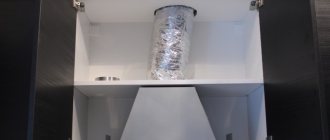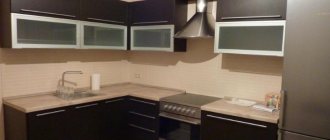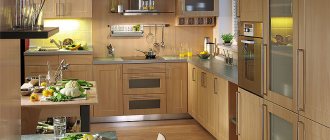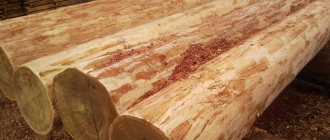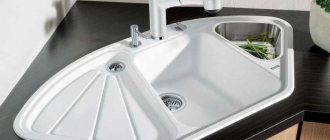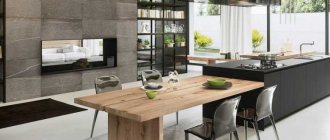How to choose a hood for the kitchen - design features and appearance
In order for the exhaust panel to bring real benefits, the following parameters are taken into account when choosing: performance, operating mode, umbrella size and design.
When the device is selected correctly, it provides 6-fold or 10-fold air exchange (depending on the mode) due to powerful fans. The hood must cover the hob completely.
Built-in models
They are located in the cabinet or on the countertop. This design is almost invisible and takes up minimal space. Suitable for small kitchens (up to 10 m). These air ducts have many configurations and are easy to match to any style of room.
Built-in panels are located horizontally or vertically, have 1-4 filters, can come with a control panel included, have backlighting and an on/off timer.
In such designs, odors and fumes pass through the filter, where they are cleaned and returned to the kitchen in the form of clean air, while grease settles on the filter.
Important! When operating such an appliance, do not open the window in the kitchen so that the appliance does not “swallow” and waste power on air from the street.
Hanging hood
It is easy to install, compact and comes in a variety of designs. But it is not suitable for a large kitchen, as it has low power and performance. Such a device is attached to the wall or ceiling and is not connected to the ventilation of the living space.
Suspended panels have a single-stage (the smell goes into the ventilation hatch) or two-stage air purification, in which it passes through a grease filter, then through a carbon filter, and then comes out clean into the room.
Dome hood
The device is ideal for spacious rooms. It is similar to a fireplace duct, always the same shape, but in two different positions: inclined or horizontal.
Of all types, this is the highest quality option, as it is made of stainless steel, has a durable coating, and can continuously purify the air using two filters: grease-absorbing and carbon. These are dual-motor devices with touch screen controls.
Reference. New types of modern hoods: “domino”, which is built into the countertop and is pulled out only during cooking, and “island” - a hanging structure above the stove, located in the center of the kitchen.
Advantages and disadvantages of built-in kitchen hoods 60 cm
When choosing a built-in 60 cm kitchen hood, you should carefully study its advantages and disadvantages.
Here are the main advantages of the device:
- the appearance of such equipment allows it to be used in any interior, since it does not catch the eye;
- the equipment takes up little space, which is important for small spaces;
- The hood does not require a large amount of electricity to operate. In addition, it operates silently.
There must be a certain distance between the hood and the work surface
It is worth noting certain disadvantages:
- productivity is not very high, since the compact device has compact dimensions;
- produced in a limited assortment.
How to determine the appropriate hood size
The main purpose of the device is to remove unpleasant odors, burning, and soot from the kitchen. The hood will cope with this task only if it completely covers the hob.
Main parameters for choosing equipment:
- The dimensions of the unit body are not important: when choosing, they are guided by the exhaust working surface of the device.
- The width of the exhaust panel should be similar to the geometric parameters of the stove and completely cover the hob during operation.
It is easier to choose a built-in model: its panel extends, increasing the area of the device. Hanging models are more often found with a width of 60 cm, which is optimal for kitchens with an area of 12-18 square meters. m.
A sixty-centimeter hood fits perfectly into the design of the room, since the standard width of wall cabinets and cabinets is also 60 cm.
If the kitchen is less than 12 sq. m, then a two-burner stove and a built-in or dome hood 45 cm wide would be more convenient.
Optimal sizes of built-in and hanging hoods for the kitchen
There will be no problems with suspended types if you start from the optimal parameters listed above. The width and depth will be the same, because the hanging equipment is produced in a square shape, which corresponds to the shape of the cooking surface. The best option would be to choose a width and depth of 60 cm. There is a large assortment of these sizes on the market today, so everyone can find an excellent option that will satisfy the design ideas and personal wishes of the buyer.
Kitchen hood sizes
The modern market offers models of different sizes and shapes.
When choosing an exhaust panel, all its dimensions are taken into account: width, height, depth and design features.
What should be the height
The height of the device itself is important, as well as the height of its installation on the stove and compliance with the height of the owner.
An incorrectly sized panel may simply not fit into the space left for it. Therefore, they focus not only on the design of the kitchen, but also take into account the distance to the ventilation to which the air duct of the device needs to be connected.
The installation height above the stove is taken into account. If this parameter is calculated incorrectly, the device will not cope with its main functions: effective removal of vapors and gases and ease of use of the workspace.
In practice, the rules for installing the exhaust system in height have been verified and recommended for safety reasons: wall-hung and built-in models are placed above electric stoves at a height of 65 cm, above gas stoves - at a height of 75 cm. If the hood is inclined, it is mounted at a level of 50-55 cm.
Important! If these parameters are violated, the panel may become deformed, ignite and fail.
The height of people who are most often in the working area of the device is taken into account: it should be above eye level. Indicators for placing the hood at 65-75 cm above the hob are designed for a person up to 180 cm tall.
If the device does not have a remote control, but only buttons on the panel, it should be located at a comfortable height for all family members.
The formula for selecting the height of the hood: the height of the ceilings minus the height of the slab minus 55-65-75 cm to the hood (depending on the type of slab) is equal to the height of the hood from the ceiling. For example, 250 cm (ceiling) - 120 cm (stove) - 65 cm (distance to the hood from the stove) = 65 cm (at this level the hood is hung from the ceiling).
Reference. If the hood is placed at the wrong height, after 5-10 days of use, a dense brown coating from grease and burning will form on the surface of the mesh.
Depth of hoods, installation safety
The depth of the kitchen hood is taken into account when placing hanging and dome models, since their dimensions are fixed: from 30 to 120 cm. The depth of the appliance is similar to the width: if the hood has a width of 45 cm, then its depth will also be 45 cm. In any case, the depth should be larger than the hob. But for built-in models, the indicator is adjusted using a retractable panel. For hanging and dome models, the depth must be measured so that it fits into the kitchen set and does not spoil the design.
How to safely install the equipment is indicated in the attached instructions. Depending on the method of air purification, there are two types of hoods: with direct connection to the air duct and recirculation hoods - when the air is cleaned in filters and returned back to the kitchen. Depending on this, the mounting locations for the hood are chosen - dowels and hooks are usually included in the kit, and additional devices, pipes and corrugations, are purchased independently.
Dependence of hood width on slab
The width of the exhaust device depends entirely on the width of the slab. If the kitchen is pre-installed and it is not possible to change the parameters of the stove and hood, make sure that the width of the stove and the hood above it are equal.
If you are just preparing for installation, choose a hood 20 cm wider than the stove. Place it in the middle of the stove so that the edges of the device on both sides extend 10 cm beyond the stove. This is the ideal placement for maximum efficiency of the device.
Standard kitchen hood dimensions (height, width, depth)
When it comes to depth, the first thing that comes to mind is dome devices. Modern equipment of this type has a square shape. The reason for this was a simple fact - hobs are produced in the same shape, so the logic is followed to the maximum.
The depth will correspond to the width, and this is from 40 to 90 cm. Again, it is necessary to select the equipment so that it completely covers the space above the hob.
The choice of height depends on the following factors:
- Type of exhaust device;
- Ceiling height;
- Performance.
The average height of a dome hood will be 125 cm. If you subtract this figure from the height of the ceilings, there should be space left for the height of the stove and the distance between the hob and the hood.
The distance from the hood to the stove: from a gas stove should be at least 65 cm, and from an electric stove - 50-60 cm. In no case is it recommended to reduce the distance - this can lead to the ignition of substances that accumulate on the grill. Also, the height indicator can be found in the manufacturer’s technical documentation.
A much better solution would be to choose retractable hoods. Their height does not exceed 20 cm, so there will be no problems with the height of the ceilings and the distance between the hob and the exhaust device.
Also, there will be no problems if the buyer’s choice falls on a recirculating type of device. Often, equipment of this type is made to a minimum height, because the device does not need to be connected to ventilation ducts.
As mentioned above, the width of the hood should correspond to the dimensions of the stove or be larger. The optimal width is 60-80 cm. It is not recommended to purchase equipment that is narrower than the cooking surface - a considerable part of the fumes will bypass the device and accumulate on the ceiling. And cleaning the hood will be difficult.
What can you buy
After a step-by-step review of how to choose the right built-in hood for the kitchen, it’s worth focusing on successful models that can be purchased on the mass market.
- Best P 580 IX 52. Representative of hoods that fit into the bottom shelf of the cabinet. The model is very successful, equipped with two backlight lamps on the inclined front panel, and has two air intake zones. The maximum productivity is 1000 cubic meters per hour, power consumption is 250 Watt, and the cutting width is 520 mm. The model is electronically controlled, works with both recirculation and exhaust, is equipped with a quiet motor, and has a noise maximum of 58 dB. The only disadvantage we can note is the lack of intensive ventilation mode.
- ELIKOR Integra 60. Representative of models that are mounted under the line of the bottom shelf of the cabinet. The hood will be useful in city apartments, its productivity is 400 cubic meters per hour, two speeds are offered, there is a backlight, the device consumes 200 Watts. The device operates both in air exhaust and in recirculation mode. The width of the cabinet for installation is 600 mm, depth is 280 mm. The model is equipped with a front strip on a pull-out shelf; it can be matched to the specific color of the furniture pediment.
- Elica Glide 90 IX. A model of an unusual shape, designed for mounting on a wall or being built under the level of the bottom of the cabinet. The maximum productivity is 1200 cubic meters per hour, the hood works both for recirculation and exhaust, a grease filter and an anti-return mechanism are offered for air movement in only one direction. The model is quite wide - 900 mm, so wall mounting will help reduce the amount of work required to modify the cabinets.
- Jetair Aurora LX 60 IX. A hood with an excellent combination of functionality and cost. It is built under the line of the bottom of the cabinet, has three speeds, simple push-button controls, a grease filter and a dirt indicator. Maximum productivity is 500 cubic meters per hour, there is a recirculation and exhaust mode, and the noise level is very pleasant - only 53 dB.
- Jetair CA Extra (52) IX. Considering the market, one cannot help but stop at hoods, which will take up enormous space inside the cabinet. Their representative, designed for insertion into the lower shelf, is Jetair CA Extra (52) IX. This hood operates on exhaust and recirculation, has a maximum capacity of 990 cubic meters, three speeds, and a grease filter. The height of the hidden block is 250 mm. You can forget about placing something in a good half of the cabinet. In addition, the model has quite impressive sound - as much as 64 dB.
How to determine the convenient depth of the device
Built-in hoods differ in depth. The housewife will have to decide which hood is better. However, there is an average preference rating.
- The first place is occupied by devices with a retractable panel. They occupy the full depth of the cabinet and allow air to be captured over a large area, above the entire hob or stove.
- In second place are hoods without a retractable part, the depth of which is equal to that of hanging interior items.
- In some cases, if the depth of the cabinets is significant or you don’t cook a lot of food on the stove, you can opt for a shallow-depth model. It occupies only part of the hanging headset. Such a hood can be embedded either closer to the wall or to the front of the cabinet.
The last choice is somewhat irrational. But such equipment may be acceptable if one person lives in the apartment, who almost never cooks on their own and the hood is needed only for ventilation and lighting.
A little about the advantages of built-in models
Few can boast of an impressive kitchen area, which can easily accommodate a central island with tables for preparing and eating food and an appropriately sized hood. Most owners of apartments and houses are simply tired of the standard chimneys of fireplace equipment, which spoil the interior. Even fewer people will give preference to simple, circulation devices, which sometimes do not so much purify the air and promote improved ventilation of the room as circulate the contents of the kitchen volume in a circle.
A modern built-in hood is one of the most convenient and practical solutions. It has a lot of advantages, both technical and consumer:
- being placed inside a hanging cabinet, the built-in hood does not spoil the design and aesthetics of the kitchen unit;
- the manufacturer provides a convenient number of device operating modes;
- the best built-in hoods, equipped with a retractable panel, easily cover the entire area of the stove and reliably remove odors;
- the best models are equipped with automation, remember the last settings; to start the ventilation process, just push the panel forward;
- The noise level of built-in hoods is noticeably lower than that of their free-standing counterparts.
The last factor is explained simply. Built-in hoods are always firmly fixed to the body of the kitchen cabinet. Therefore, the level of vibration is lower, and, accordingly, the noise produced is lower. Due to this, this type of equipment often tops the rating of buyer preferences when choosing a specific model.
The last thing worth dwelling on, although we could list the advantages of the hoods in question for a long time, is the influence of the device on the aesthetics of the kitchen. The fact that it can be built in immediately allows you not to spoil the appearance of the headset by masking its location in the cabinet.
The second important factor, which further increases the rating of the equipment in the eyes of the buyer, is the simplicity of the device, which is completely hidden from view by the air duct. The outlet of the built-in hood is located directly on the top of the kitchen cabinet, close to the wall. Therefore, even a simple corrugated pipe will have a minimum of areas open to view. And if you use a good solution in the form of a flat box for the air duct, it will become completely invisible.
Hood width
This is one of the key characteristics for the following reasons.
Firstly, your new hood should not be narrower than the corresponding hob over which it will be installed.
If it is narrower, then all the particles of moisture and fat that should have gone into the hood will settle somewhere on the sides or even the facades of the furniture.
Secondly, due to the fact that it is built-in, you need to know its dimensions with millimeter accuracy and provide them to the designer who is preparing the kitchen project.
